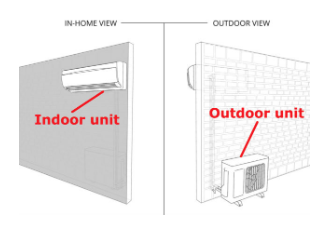How Does a Ductless AC System Work?
January 14, 2019

Before answering how a ductless AC System works, we should probably explain exactly what a ductless AC system is. A ductless AC system works just like a central AC system in that it removes heat from the air and pushes that heat outdoors, leaving you with cooler air.
Essentially, a ductless AC system is exactly what it sounds like: a primary AC system, but one that functions without ducts.
Okay, but how?
We thought you’d ask, so below we’ll break down:
How a mini-split cools your home—without ducts
The benefits of a ductless system
The cost of a ductless system
Let's start by taking an in-depth look at the different parts of a ductless system and how it works.
Want a FREE quote to install a ductless system in your home?
How does a ductless system work?
A ductless system works by removing heat from your home using 2 main units, much like a central AC system:
Outdoor compressor unit
The compressor
Condensing coil
The fan
Indoor unit(s)

The two main units of a mini-split AC system.
All ductless AC systems will have these two main units, but depending on whether a system is mini-split or multi-split, it may have more indoor units.
Mini-split systems: This is a ductless system which cools only one room or space via one outdoor unit.
Multi-split systems: This is a ductless system which can cool up to 8 rooms with one outdoor unit.
How do these units work together to produce cold air?
The indoor unit sucks in warm, unconditioned air from your home and absorbs the heat from that air.
The heat from that warm air is transferred to the outside unit where that heat is dumped outside via a large fan.
The (now cool) air that has been stripped of heat is then cycled back into the living area as cool air.
Sound like a central AC system without the ducts? You got it! The biggest differences between a ductless system and a central AC system are:
A central AC indoor unit is large and is located in an attic, crawl space or closet. In a ductless AC system, the indoor unit is fairly small and is located in the room or space it is cooling.
Central AC systems have 1 air handler, evaporator coil and blower and air is blown into each room by ducts that are all connected to one central place. Indoor ductless systems include an evaporator coil and a fan in the same unit, making it an efficient and convenient way to cool or heat one room or space without losing energy from the ducts.
Why implement a ductless system?
Due to the fact that ductless AC systems are not part of a central AC system, they are typically used for:
Rooms or spaces that have been added on at a later time. This could include spaces like a garage that have been turned into a bedroom/office, or rooms that were added after the original central duct system was installed.
Homes without a central heating and/or cooling system. A ductless AC unit is useful if there is not a central heating or cooling system in place.
Better security. Because ductless systems require a small hole to be cut into the wall, it makes this system fairly immune to the disadvantages that window units bring, i.e. air leakage and potential security threats.
Energy efficiency. Duct systems are typically less energy efficient because those ducts allow systems to lose hot/cool air (you can lose more than 30% of energy through your ducts). The perk of a system without ducts is that you retain this otherwise lost energy.
What are the costs associated with a ductless system?
A ductless system is generally more expensive than a central AC system. However, the overall installation cost is cheaper when you take into account the additional expense of adding ductwork, which is an additional $5,000–$10,000.
Interested in learning more about a ductless system?
- Posted in:
- Air Conditioner

